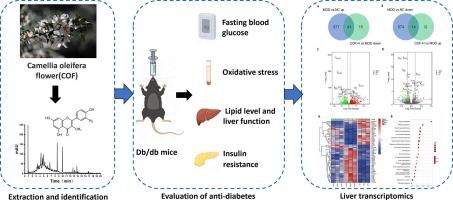Flavonoids from Camellia oleifera flower ameliorate type 2 diabetes mellitus by regulating the p53 pathway
IF 2.5
3区 医学
Q3 CHEMISTRY, MEDICINAL
引用次数: 0
Abstract
Background
Camellia oleifera flower (COF) is rich in flavonoids and polyphenols, strongly preventing postprandial hyperglycemia and improving diabetes. However, research on the effective ingredients in COF extracts that have hypoglycemic effects is limited, and the mechanism by which COF extracts improve liver insulin resistance and glucose and lipid metabolism still needs to be clarified, requiring further investigation.
Aim
To systematically clarify the role of COF extracts in improving insulin resistance in diabetes mice and to explore their key targets and mechanisms in anti-type 2 diabetes (T2DM).
Materials and methods
Ultrafiltration combined with liquid chromatography-mass spectrometry (UPLC-Q-MS) was used to analyze α-glucosidase inhibitors in COF extracts qualitatively. Blood glucose, lipid, oxidative stress, and liver function indicators were detected in the db/db type 2 diabetes mouse model. Then, RNA-seq was used to identify differentially expressed mRNAs (DEGs) in the liver, screen for key genes and metabolic pathways, and validate the results' accuracy through qPCR experiments.
Results
17 α-glucosidase inhibitors were identified as flavonoids from COF. Through db/db type 2 diabetes mouse model, it was indicated that COF could significantly improve symptoms of hyperglycemia and hyperlipidemia, alleviate oxidative stress, and protect liver and pancreatic tissues by regulating key differential genes expressed, including Nek2, Cdk1, Ccnb1, and Ccnb2 via the p53 signaling pathway and ameliorate the insulin resistance effect.
Conclusion
This study demonstrated the anti-diabetic effect of COF, explored its potential hypoglycemic target, and provided data support for future T2DM prevention and drug treatment.

油茶花中的黄酮类化合物通过调节 p53 通路改善 2 型糖尿病。
背景:油茶花(COF)富含黄酮类化合物和多酚类物质,可有效预防餐后高血糖,改善糖尿病。目的:系统阐明COF提取物在改善糖尿病小鼠胰岛素抵抗中的作用,探讨其在抗2型糖尿病(T2DM)中的关键靶点和机制:超滤结合液相色谱-质谱法(UPLC-Q-MS)定性分析 COF 提取物中的α-葡萄糖苷酶抑制剂。检测了 db/db 2 型糖尿病小鼠模型的血糖、血脂、氧化应激和肝功能指标。然后,利用 RNA-seq 鉴定肝脏中差异表达的 mRNA(DEGs),筛选关键基因和代谢通路,并通过 qPCR 实验验证结果的准确性:结果:从COF中鉴定出17种α-葡萄糖苷酶抑制剂为黄酮类化合物。通过 db/db 2 型糖尿病小鼠模型,表明 COF 可通过 p53 信号通路调节 Nek2、Cdk1、Ccnb1 和 Ccnb2 等关键差异基因的表达,显著改善高血糖和高脂血症症状,减轻氧化应激,保护肝脏和胰腺组织,并改善胰岛素抵抗效应:本研究证明了 COF 的抗糖尿病作用,探索了其潜在的降血糖靶点,为未来 T2DM 的预防和药物治疗提供了数据支持。
本文章由计算机程序翻译,如有差异,请以英文原文为准。
求助全文
约1分钟内获得全文
求助全文
来源期刊

Fitoterapia
医学-药学
CiteScore
5.80
自引率
2.90%
发文量
198
审稿时长
1.5 months
期刊介绍:
Fitoterapia is a Journal dedicated to medicinal plants and to bioactive natural products of plant origin. It publishes original contributions in seven major areas:
1. Characterization of active ingredients of medicinal plants
2. Development of standardization method for bioactive plant extracts and natural products
3. Identification of bioactivity in plant extracts
4. Identification of targets and mechanism of activity of plant extracts
5. Production and genomic characterization of medicinal plants biomass
6. Chemistry and biochemistry of bioactive natural products of plant origin
7. Critical reviews of the historical, clinical and legal status of medicinal plants, and accounts on topical issues.
 求助内容:
求助内容: 应助结果提醒方式:
应助结果提醒方式:


